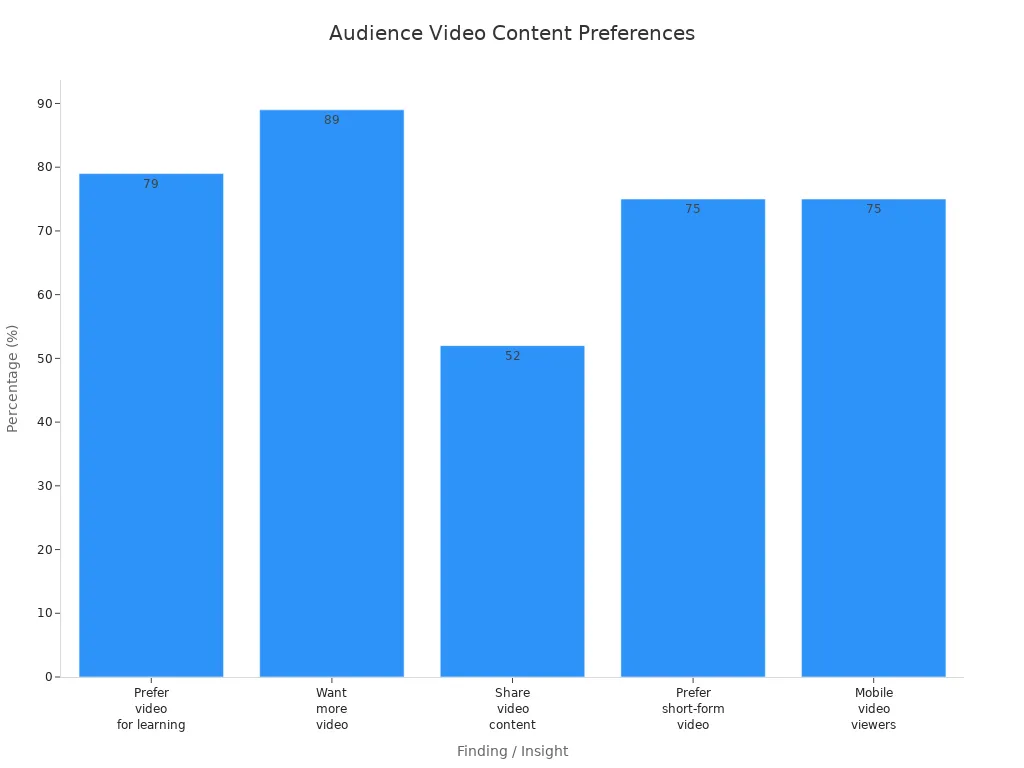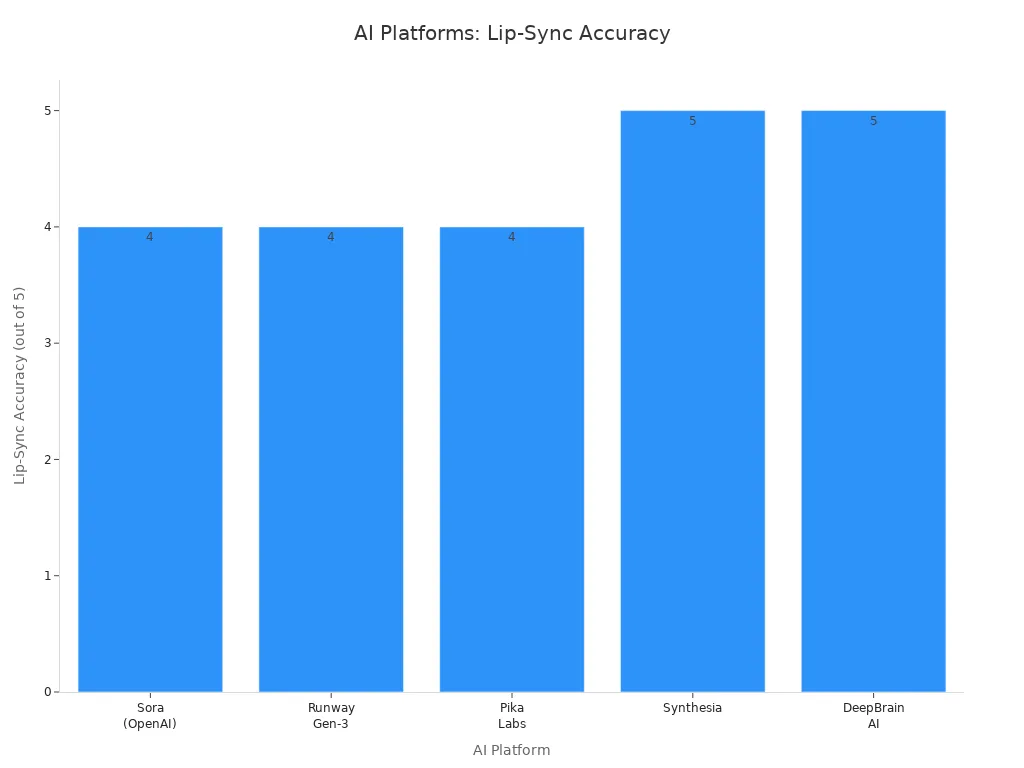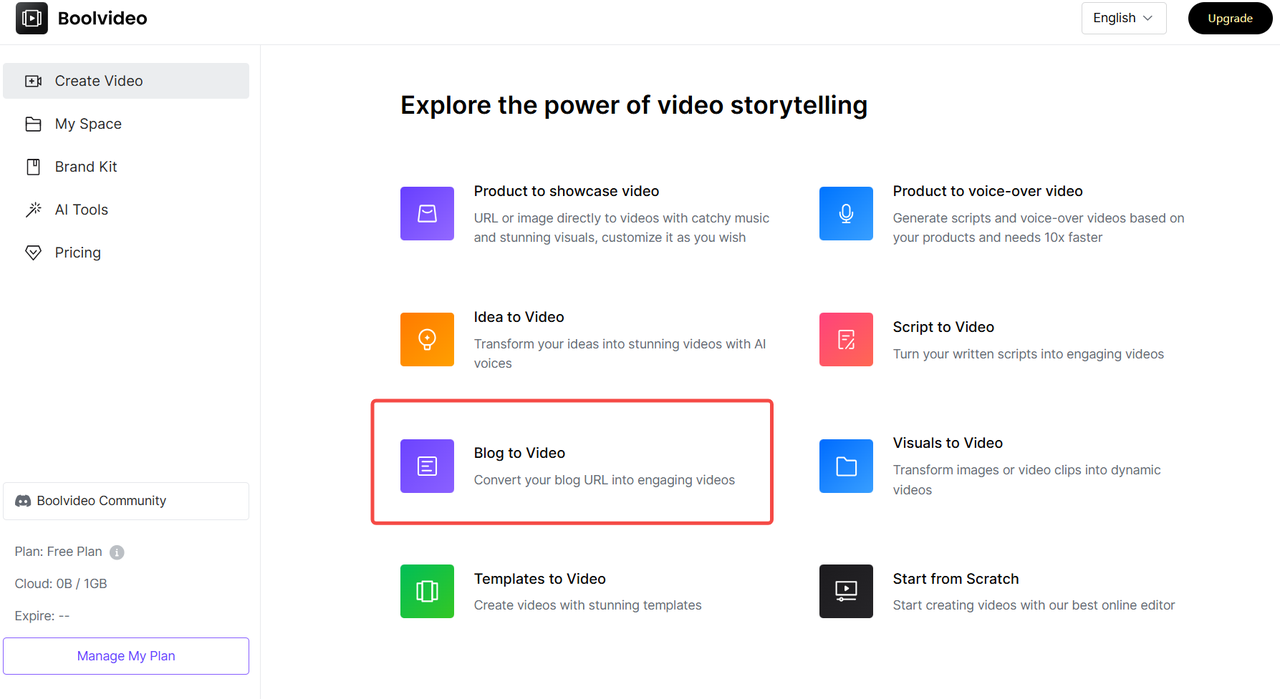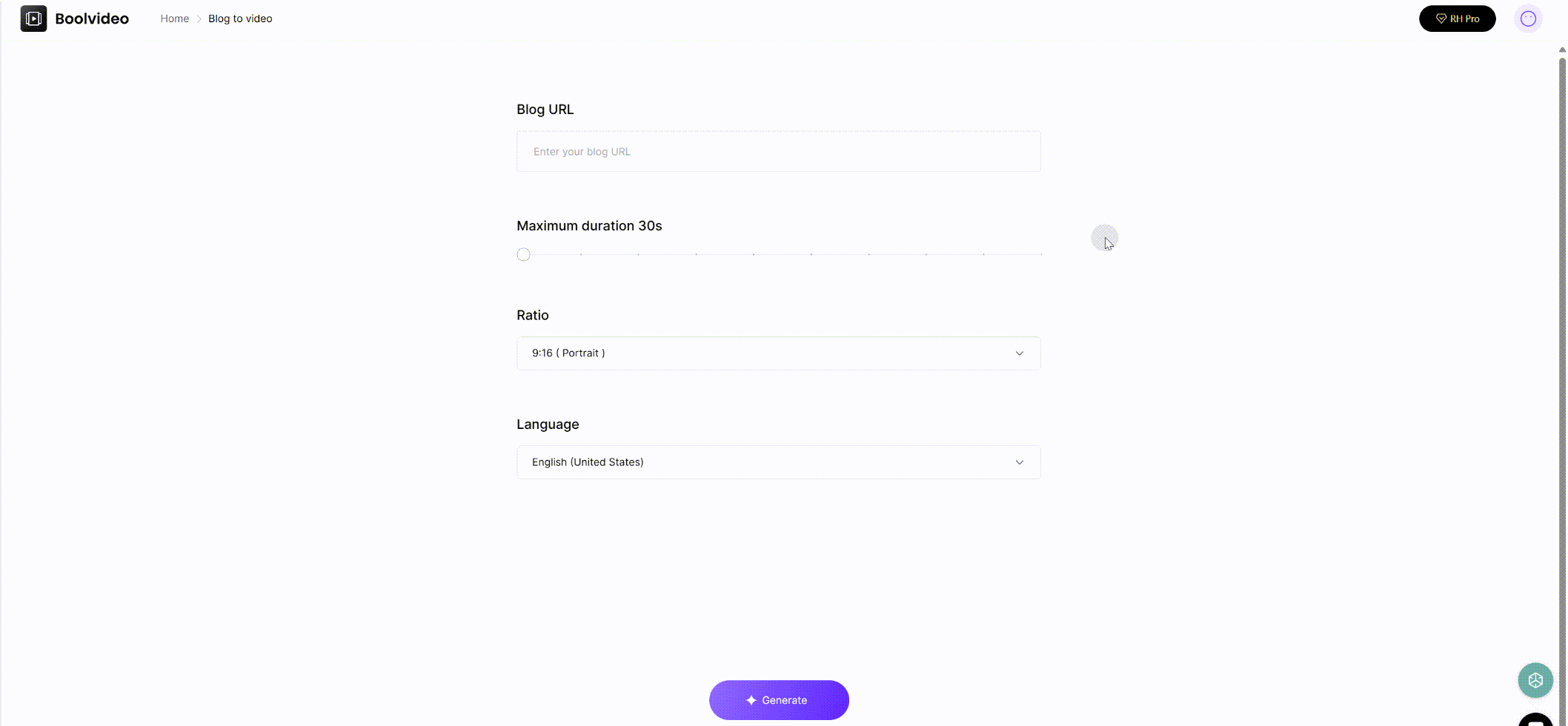How to Convert Blog Posts into Videos with AI Tools in 2025

You can now convert blog posts into videos in just minutes, thanks to powerful AI tools in 2025. Creating engaging videos easily no longer takes hours or days. With tools like Pictory and Fliki, you simply paste your article and watch as your blog posts into videos transform into eye-catching video content. You do not need special skills. This article shows you how to turn blogs into videos with less effort, so your article reaches more people.
Why Turn Blog Posts into Videos
Boost Engagement and Reach
Changing your blog posts into videos helps you reach more people. Videos keep people interested for longer. Many people like to watch videos instead of reading. About 79% of people learn better by watching videos. Also, 89% want to see more video content from brands. Short videos are good because people are busy and have short attention spans. TikTok and Instagram help you share these videos easily and get noticed.
Finding / Insight | Statistic / Explanation |
|---|---|
Consumers preferring video over text for learning | 79% |
Consumers wanting more video content from brands | 89% |
Likelihood of video content being shared | 52% more likely than other content types |
Preference for short-form video to learn products | 75% |
Mobile device video consumption | Approximately 75% of viewers |
Videos get shared more often than other content. They also help people stay on your site longer. Tweets with videos get 10 times more engagement. Videos on LinkedIn under 30 seconds get watched more. When you turn an article into a video, you give your audience more ways to connect.

Improve SEO and Repurposing
Adding videos to your website helps your pages show up higher in search results. Google likes pages with videos because people stay longer and interact more. Pages with videos are 53 times more likely to be on the first page of Google. Visitors spend 88% more time on sites with videos than on sites with only text. This means your article can reach more people if you add a video.
Repurposing content makes your work go further. Turning blog posts into videos gives people new ways to find your message. You can share the same idea in different formats. Try short clips for social media or longer videos for YouTube. This keeps your content fresh and helps you reach new people. AI tools make repurposing easy and fast. You can spend more time sharing your story and less time starting over.
Tip: Turning your best articles into videos can help them last longer and improve your video marketing.
Best Content for Video Generation

How-To and Listicles
You might wonder which blog posts work best for AI video tools. How-to articles and listicles stand out as top choices. These posts have a clear structure and break information into simple steps or points. This makes it easy for AI to turn your words into a video script.
How-to articles show each step in a process. AI tools can turn these steps into scenes, making your video easy to follow.
Listicles use numbered or bulleted lists. This format helps AI pick out key points and create a storyboard quickly.
Tutorials often include images or screenshots. AI can use these visuals to make your video more interesting.
The simple language in these posts helps viewers understand the message fast.
AI-powered tools can handle storyboarding, visual selection, and even voiceovers, so you save time.
Tip: If you want your videos to grab attention, start with a how-to or a listicle. These formats keep things clear and engaging for your audience.
Listicles and how-to guides also work well because they use a friendly tone. People like watching videos that feel easy to follow and fun to share.
Guides and FAQs
Guides and FAQ blog posts also shine when you turn them into videos. These types of content often answer common questions or explain topics in detail. AI tools can quickly turn long guides into short, helpful clips for social media.
Aspect | How AI Helps with Guides & FAQs |
|---|---|
Time Efficiency | |
Content Conversion | Automates script, voiceover, and editing |
Audience Optimization | Tailors video style for each platform |
Content Repurposing | Turns long guides into short video clips |
Quality & Creativity | Blends AI speed with your creative ideas |
Branding Consistency | Keeps your videos looking and sounding alike |
Marketing Practices | Adds calls-to-action and platform tweaks |
You can use AI to keep your branding strong across all your videos. Guides and FAQs often become a series, so having a consistent look helps your viewers recognize your content. AI also helps you test what works best, so you can keep improving your videos over time.
Step-by-Step: Blog Posts into Videos
Step 1: Start with Your Blog
What to Do: Go to Boolvideo’s “Blog to Video” page.
Step 2: Enter your blog URL
What to Do:
Paste your blog URL.
Select settings:
Duration: 15s to 10 minutes.
Language: 50+ options (English, Spanish, Japanese, etc.).
Aspect Ratio: Auto-adapt for platforms (e.g., 9:16 for TikTok).
Step 3: Customize Your Video (Optional)
What to Do: Click “Edit in Timeline” to fine-tune:
Visuals: Apply filters, add text/stickers, or upload your own clips.
Pacing: Drag to reorder scenes or trim clips.
Voice & Music: Adjust volume or upload custom background tracks.
Localization: Translate subtitles/voiceovers for global audiences.
Step 4: Export & Share
What to Do: Click “Download” or directly share to:
YouTube
Instagram Reels
TikTok
Facebook
Done! Your video is ready to captivate audiences. 🚀 Turning blog posts into videos is easier than ever in 2025. You can use an ai video assistant or an automated text-to-video generator to speed up the process. Let’s break down each step so you can start creating videos that grab attention and boost your reach.
Select and Outline Content
Start by picking the right blog post. Choose evergreen topics, how-to guides, listicles, or posts that get lots of traffic but not much engagement. These types work best when you want to convert blog posts into videos.
Next, outline your content. Think about your audience. What do they want to learn or see? Make a list of the main points. Keep it simple. A good outline has a catchy headline, a short intro, three to five key takeaways, and a call to action at the end. This structure helps your ai video assistant understand what matters most.
Tip: Use a table to compare your top blog posts. Look for posts with clear steps, strong visuals, or popular topics.
Blog Post Type | Why It Works for Video |
|---|---|
How-To Guides | Easy to break into steps |
Listicles | Simple points for each scene |
FAQs | Answers common questions |
Evergreen Content | Stays relevant over time |
Generate the Video Script with AI Tools
Now it’s time to create your script. You can use ai tools like ChatGPT, VEED.IO, or Lumen5. Just paste your outline or main points into the tool. The ai video assistant will help you generate a video script in seconds.
Most ai tools let you pick the tone and style. You can choose friendly, professional, or even funny. The script usually starts with a hook, then covers your main points, and ends with a call to action. You might need to tweak the script a little to match your brand or voice.
Some platforms, like Synthesia, let you paste the blog URL. The ai video assistant will scan your post and generate the video script for you. This saves time and keeps your message clear.
Note: AI-generated scripts are fast and consistent, but always review them. Add your own touch to make the video feel personal.
Video Generation with AI Platforms
After you have your script, you can generate a video using an ai video creation tool. Here are some of the top platforms in 2025:
AI Tool | What It Does |
|---|---|
Synthesia | Uses avatars, supports 120+ languages, easy editing |
Lumen5 | Turns text into animated videos quickly |
VEED.IO | Offers drag-and-drop editing, voice cloning |
Pictory AI | Converts blog posts into short video clips |
HeyGen | Custom templates, brand tools, API automation |
Descript | Repurposes blogs into short video content |
Canva+HeyGen | Combines design and video generation |
You can upload your script, pick visuals, and even add AI voiceovers. Some platforms let you generate and download the video by just pasting your blog URL. Others give you more control, so you can choose images, music, and avatars.
Many ai video assistants support different content formats. You can use text, PDFs, slides, or even web pages. They also handle many languages and accents, so your video can reach a global audience.
Tip: Try a short video first. See how your audience reacts before making longer videos.
Edit and Optimize for Platforms
Editing and optimizing your video is key. Each platform has its own rules. For YouTube, use a widescreen (16:9) format. Instagram and LinkedIn like square (1:1) videos. TikTok and Instagram Reels work best with vertical (9:16) videos.
Add subtitles and captions. Many people watch videos with the sound off. Use strong hooks in the first few seconds. Add bold text on the screen to catch attention. Make sure your call to action fits the platform. For YouTube, say “Subscribe for more.” On Instagram, try “Check the link in bio.”
Batch your videos to save time. Use platform tools like stickers, trending sounds, and hashtags. This helps your video look native and boosts your reach.
Note: Always check your video’s performance. Look at watch time, likes, and shares. Use this info to improve your next video.
You can now generate a video for each platform and optimize it for the best results. With the right ai tools and a smart workflow, you can turn blog posts into videos that stand out on YouTube, Instagram, TikTok, and LinkedIn.
Automate and Streamline Video Generation
Workflow Automation Tools
You can save a lot of time by using workflow automation tools for your blog-to-video process. Tools like Zapier and Make.com help you connect your blog, AI video platforms, and social media. When you publish a new blog post, Zapier can trigger video automation. It grabs your blog content, sends it to an AI video tool, and then uploads the finished video to youtube, LinkedIn, or TikTok. You do not have to do each step by hand.
Here’s how a simple workflow might look:
Zapier sees a new blog post on your site.
It sends the text to a video generation tool.
The tool creates a video using your template.
Zapier posts the video to youtube with a title and call to action.
Make.com gives you a visual way to build these workflows. You can drag and drop steps, making it easy to see how everything connects. Cflow is another tool that helps you automate tasks, like script writing or adding captions. These platforms cut out boring, repetitive work and let you focus on creative ideas.
Tip: You do not need to know how to code. Most automation tools use simple menus and templates.
Bulk and Recurring Video Creation
If you want to turn many blog posts into videos at once, some AI tools offer bulk and scheduled video automation. This means you can queue up lots of blog articles and let the tool make videos for each one. You can even set a schedule, so new videos appear every week or month.
Here’s a quick look at some tools that help with bulk and recurring video creation:
AI Tool | Bulk/Scheduled Video Features | Notable Features |
|---|---|---|
Batch video queue, scheduling, analytics | Realistic avatars, top lip sync | |
AutoShorts.ai | Fully automated, multi-channel posting, scheduling | Set-and-forget, supports many channels |
Bulk video creation, multi-language support | Lifelike avatars, good for scaling |
These tools make it easy to keep your youtube channel or social pages active. You can plan ahead and let the system handle the rest. AI helps with editing, script writing, and even adding subtitles. This saves you hours every week.
Keep in mind, some challenges exist. Sometimes, workflows can get complicated, or you may need to adjust settings for each platform. Also, always check your videos for quality and accuracy before posting.
Note: Bulk video automation works best when you have lots of evergreen content or want to keep a steady posting schedule.
Best Practices for AI Tools
Keep Videos Engaging
You want people to watch your videos all the way through. Start your video with something important. Share your main idea right away. Use a friendly script that sounds like you are talking to a friend. Ask questions or tell viewers what to do next. People like it when you talk to them directly.
Try these ideas to make your videos more fun:
Make your script short and easy to understand. Get to your point quickly.
Show pictures and animations that fit your brand and message.
Change scenes often. Add moving words or pictures to keep people watching.
Pick the right video shape for each app. Use tall videos for TikTok and wide ones for LinkedIn.
Add captions and translations using AI tools. This helps more people enjoy your videos.
Mix AI tools with your own ideas. Show your style and make your videos feel real.
Use AI to see what people like. Make your next video better by using their feedback.
Want more people to watch? Try adding things like quizzes or questions. Make videos for different groups. This helps each video feel special.
Branding and Accessibility
Your videos should always look and sound like your brand. Use the same colors, fonts, and logos in every video. Pick templates that match your style. This helps people know your videos right away.
Accessibility is important too. AI tools in 2025 make it easy to add subtitles and audio descriptions. The best platforms make good captions and change them for different languages. You can reach more people by making videos in many languages. Always check that your videos have strong colors and clear words. This helps everyone, even people with low vision or dyslexia.
Here’s a simple checklist for branding and accessibility:
Practice | Why It Matters |
|---|---|
Consistent colors/logos | Builds trust and brand recognition |
Accurate subtitles | Makes videos accessible to all |
Multiple languages | Expands your global audience |
High-contrast visuals | Improves readability |
Quality checks | Keeps your videos professional |
Tip: Watch your video before you post it. Make sure it looks good on phones and computers. Leave space for sign language if you need it.
AI video tools now have better accessibility features. They can make subtitles and audio descriptions very fast, with almost perfect accuracy. This means you can make great videos that everyone can enjoy.
You can start turning your blogs into videos today—no editing skills needed. AI tools make the process simple and fast. Just look at the numbers:
Metric | Blog Posts | Videos | Percentage Change |
|---|---|---|---|
Average Time on Page | 5 minutes | +150% | |
Bounce Rate | 60% | 40% | -33% |
Social Shares | 50 | 150 | +200% |
Conversion Rate | 2% | 4% | +100% |

Ready to get started? Try these steps:
Pick a blog post you love.
Choose an AI platform like Pictory or Synthesia.
Follow the prompts to create your first video.
You’ll see more engagement and reach in no time!
FAQ
How long does it take to turn a blog post into a video with AI?
You can make a video in just a few minutes. Most AI tools work fast. You just paste your blog, pick a style, and let the tool do the rest.
Do I need video editing skills to use these AI tools?
No, you do not need any editing skills. The AI handles everything for you. You just follow the steps and make small changes if you want.
Can I use my own branding in the videos?
Yes! Most AI video tools let you add your logo, colors, and fonts. This helps your videos match your brand and look professional.
What types of blog posts work best for video conversion?
Tip: How-to guides, listicles, and FAQs work best. These formats have clear steps or points, so the AI can turn them into easy-to-watch videos.
Will the AI add subtitles to my videos?
Most AI tools add subtitles automatically. You can edit them if you want. Subtitles help more people watch and understand your videos.
See Also
Transform Your Blog Into Engaging Videos Using AI
Effortlessly Turn Blog Posts Into Videos With AI
Use AI Tools To Animate Your Videos Seamlessly





